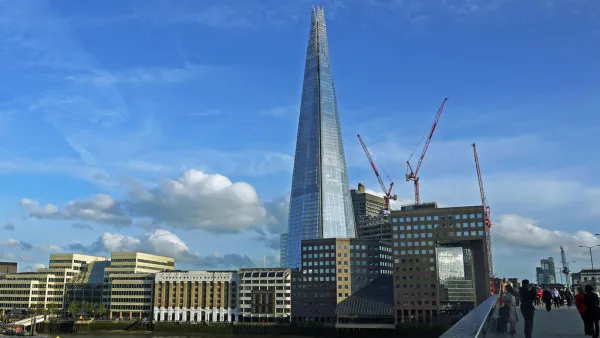Sure, it's a subjective question. Where I live, it's anything taller than four stories, at least in the local media's eyes. But from a real estate perspective, there really is a minimum number, and they are being built in record numbers in the U.S.
Conor Dougherty writes from Minneapolis where he describes one of two new luxury residential high-rises set to open in downtown in August. The Nic on Fifth, a "26-story apartment building that sits smack on a light-rail stop and boasts amenities like a pool deck and a private dog park," is representative of what is becoming increasing more common throughout the U.S. (though I'm not sure how many of these towers can boast private dog parks).
For more information on this transit oriented development, see "The Nic on Fifth Brings Luxury Living to Minneapolis’ Nicollet Mall" by The Opus Group.
Axiometrics, a Dallas apartment-research firm, defines a tower as 15 stories or more, writes Dougherty.
This year, some 74 rental towers are on pace to be completed, and there are 81 on the books for 2015—the highest number since at least the 1970s. At the same time, strong apartment rents and sluggish demand for office space have resulted in some high-rise buildings being converted to apartments. [See chart showing 2005-2015 data].
Dougherty writes that while the high-rise residential towers are more likely to be built in "denser and pricier markets like San Francisco, New York and Chicago, (b)ut in percentage terms, the increase has been most dramatic in smaller cities like Minneapolis, which is building apartments, including high-rise apartment buildings, at the fastest pace in decades."
"It's the Manhattanization of America and it's happening in cities that never had rental high rises," says Mark Humphreys, chief executive of Dallas-based Humphreys & Partners Architects, which specializes in apartments and condominiums.
Going back to the suburban cities that I'm familiar with in the Bay Area, residential opponents, even judges at times (e.g. Redwood City, Calif.) would appear to decry almost any multi-family new development, regardless of its height, as a symbol of the "Manhattanization" of their city. Could that loaded term be taking on a new, more positive meaning?
FULL STORY: High-Rise Apartment Buildings Sprout in Downtowns Nationwide

National Parks Layoffs Will Cause Communities to Lose Billions
Thousands of essential park workers were laid off this week, just before the busy spring break season.

Retro-silient?: America’s First “Eco-burb,” The Woodlands Turns 50
A master-planned community north of Houston offers lessons on green infrastructure and resilient design, but falls short of its founder’s lofty affordability and walkability goals.

Delivering for America Plan Will Downgrade Mail Service in at Least 49.5 Percent of Zip Codes
Republican and Democrat lawmakers criticize the plan for its disproportionate negative impact on rural communities.

Test News Post 1
This is a summary

Test News Headline 46
Test for the image on the front page.

Balancing Bombs and Butterflies: How the National Guard Protects a Rare Species
The National Guard at Fort Indiantown Gap uses GIS technology and land management strategies to balance military training with conservation efforts, ensuring the survival of the rare eastern regal fritillary butterfly.
Urban Design for Planners 1: Software Tools
This six-course series explores essential urban design concepts using open source software and equips planners with the tools they need to participate fully in the urban design process.
Planning for Universal Design
Learn the tools for implementing Universal Design in planning regulations.
EMC Planning Group, Inc.
Planetizen
Planetizen
Mpact (formerly Rail~Volution)
Great Falls Development Authority, Inc.
HUDs Office of Policy Development and Research
NYU Wagner Graduate School of Public Service



























